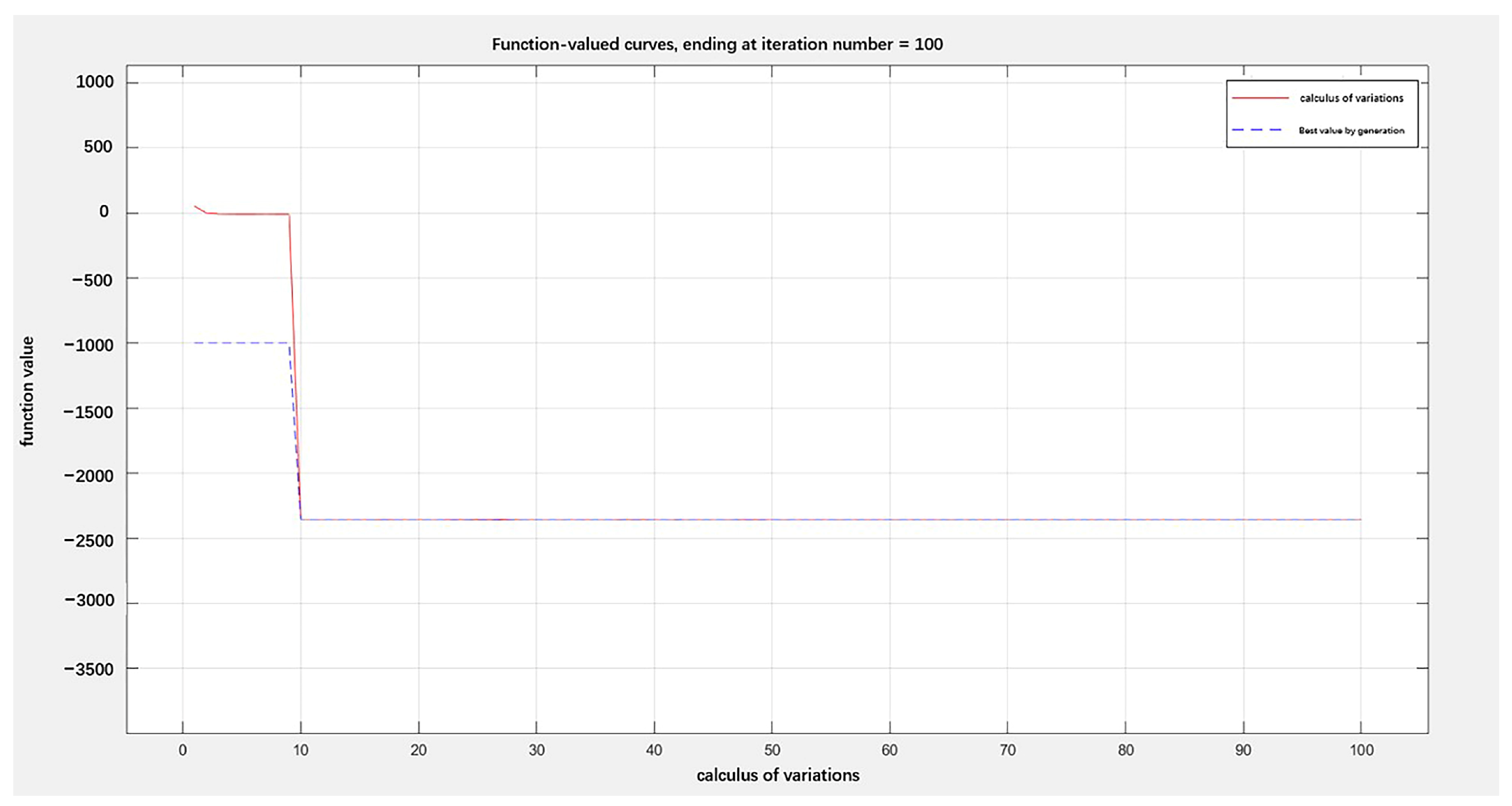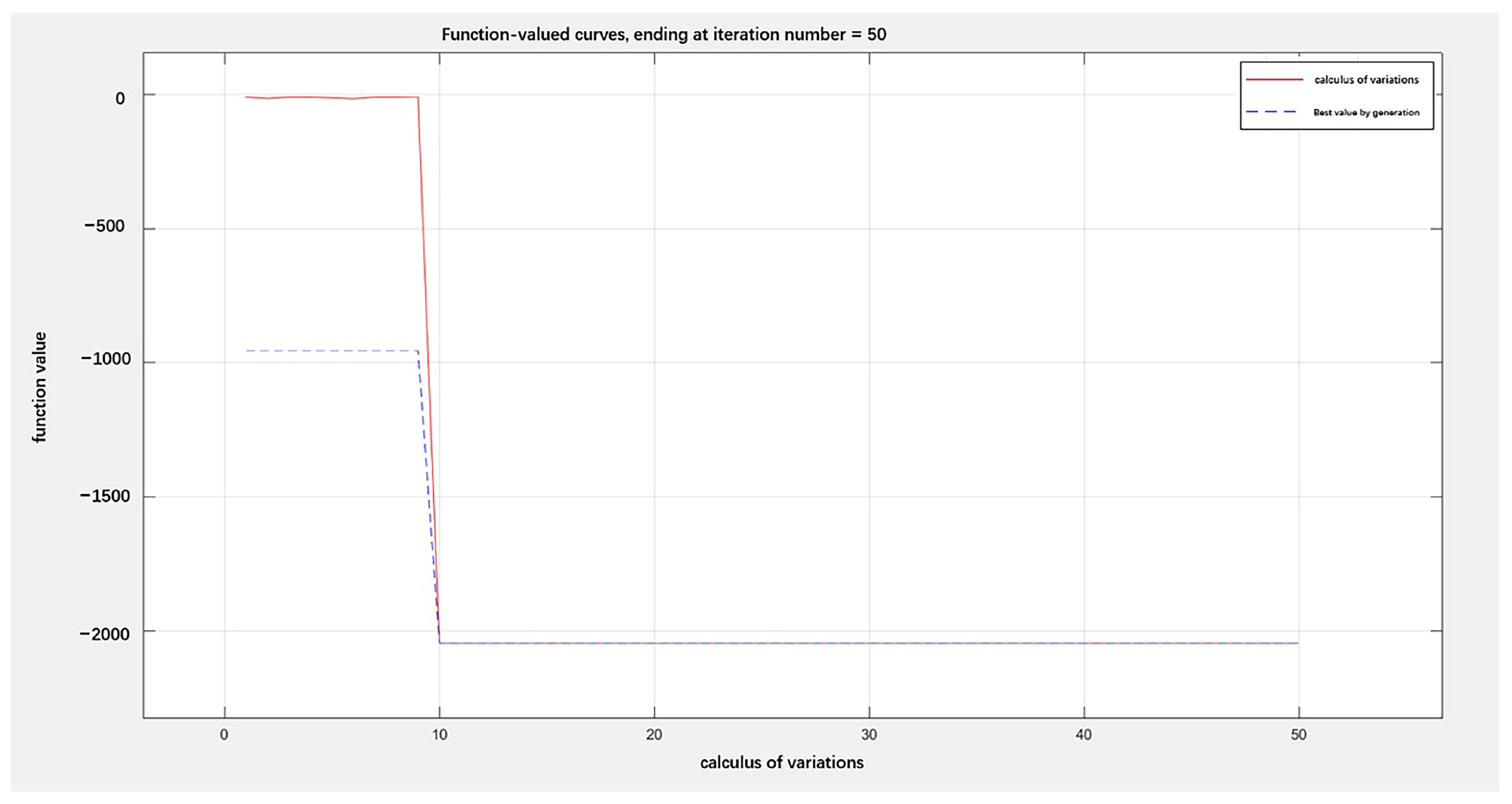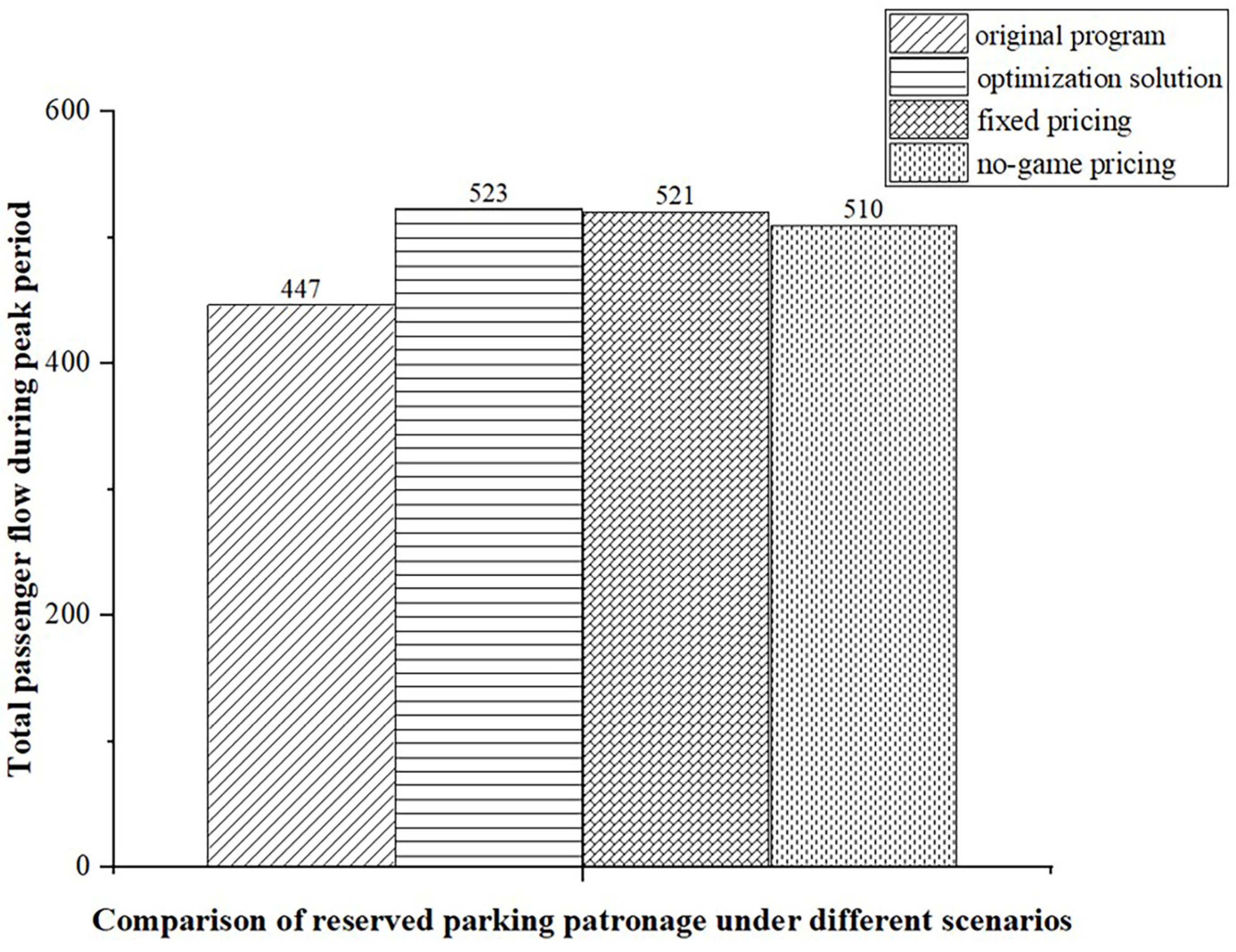Game-Based Demand Feedback Reservation Parking Pricing
Abstract
:Featured Application
Abstract
1. Introduction
2. Literature Review
3. Application and Innovation
4. Reservation Strategy and Rules
4.1. Reservation Strategy
4.2. Rules for Reservation Service
- Rule 1: The hours of operation of a parking lot attached to a commercial facility shall be used as the total hours of service.
- Rule 2: Individual periods of service shall be of one hour in length, with adjacent periods of service succeeding each other.
- Rule 3: Users who have made a reservation must enter the garage and park in the available parking space of their choice between 15 min before and 15 min after the start of the reserved service period. The first service period entry is 30 min after the opening.
- Rule 4: After the service has ended, the user is required to remove the vehicle from the parking lot within 15 min of the start of the next unreserved service period. Exceeding the time limit is considered a default, and defaulting vehicles exceeding the time limit will be placed in the reserved garage.
- Rule 5: Users may only book the next service period from the current moment to the last service period within the operating session.
- Rule 6: Users can only operate reservations for one vehicle at a time, and no withdrawal is allowed after payment.
- Rule 7: Reservation of parking spaces is on a first-come-first-served basis, and when “the number of occupied parking spaces + the number of reservations ≤ the total number of parking spaces in the car park”, the reservation of parking spaces for that period is no longer allowed.
- Rule 8: When a user makes a request for parking unreservedly, it is considered a “reservation from the next nearest service period” and the parking lot manager quotes a price for the user, who agrees to the service and then enters the reserved garage and waits for the opening of the available parking slot.
5. Nested Logit and Game Modeling Proposed
5.1. User Behavioral Choices
- Option 1: Select reservation parking.
- Option 2: Choose other parking lots in the neighborhood.
- Option 3: Choosing other modes of travel.
5.2. Parking Pricing Analysis
5.2.1. Reservation Parking Lot Pricing
5.2.2. Neighborhood Traditional Garage Pricing
5.3. Stackberg Gaming between Parking Lots
6. Instance Validation
6.1. User Choice Behavior Fitting
- Parking reservations
- 2.
- Traditional parking in the neighborhood
- 3.
- Other modes of travel
6.2. Solving the Game Pricing Model
6.3. Comparative Analysis of Pricing Strategy Returns
6.3.1. Traditional Flat-Rate Pricing
6.3.2. Autonomous Pricing without Gaming
6.3.3. Comparative Analysis of Program Results
7. Conclusions
- In this paper, we propose a new reservation parking strategy for commercial districts where users can freely choose the combination of reservation time slots. In addition, based on the nested logit model and Stackberg model, the derivation process of the profit of a reservation parking lot is given more systematically. From the example experiments, it can be seen that the model demands fewer and easily accessible independent variables, while specific price schemes can be obtained with a high degree of applicability.
- The feasibility of using nested logit for the user selection of specific time slots in the parking reservation mechanism is partially verified by an example. This paper is also the first time that nested logit is introduced into the direction of passenger flow analysis for reserved parking, which can provide some ideas for subsequent research on reserved parking pricing.
- Parking lots can dynamically adjust their own prices by using the attributes of the traffic flow and the strategies of neighboring parking lots to develop a reasonable pricing scheme. Lower prices for several time slots may mean a higher traffic attraction and higher profits.
Author Contributions
Funding
Institutional Review Board Statement
Informed Consent Statement
Data Availability Statement
Conflicts of Interest
References
- Wu, W.; Liu, W.; Zhang, F.; Dixit, V. A New Flexible Parking Reservation Scheme for the Morning Commute under Limited Parking Supplies. Netw. Spat. Econ. 2021, 21, 513–545. [Google Scholar] [CrossRef]
- Geng, Y.; Cassandras, C.G. Dynamic resource allocation in urban settings: A “smart parking” approach. In Proceedings of the 2011 IEEE International Symposium on Computer-Aided Control System Design (CACSD), Denver, CO, USA, 28–30 September 2011; pp. 1–6. [Google Scholar] [CrossRef]
- Chen, Z.; Yin, Y.; He, F.; Lin, J.L. Parking Reservation for Managing Downtown Curbside Parking. Transp. Res. Rec. 2015, 2498, 12–18. [Google Scholar] [CrossRef]
- Chou, S.Y.; Arifin, Z.; Dewabharata, A. Optimal decision of reservation policy for private parking sharing system. In Proceedings of the International Conference on Computer, Control, Informatics and its Applications (IC3INA), Tangerang, Indonesia, 1–2 November 2018; pp. 66–71. [Google Scholar] [CrossRef]
- Tian, Q.; Yang, L.; Wang, C.; Huang, H.J. Dynamic pricing for reservation-based parking system: A revenue management method. Transp. Policy 2018, 71, 36–44. [Google Scholar] [CrossRef]
- Mouskos, K.C.; Tvantzis, J.; Bernstein, D.; Sansil, A. Mathematical formulation of a deterministic parking reservation system (prs) with fixed costs. In Proceedings of the 10th Mediterranean Electrotechnical Conference, Information Technology and Electrotechnology for the Mediterranean Countries, MeleCon 2000 (Cat. No. 00CH37099), Lemesos, Cyprus, 29–31 May 2000; pp. 648–651. [Google Scholar] [CrossRef]
- Inaba, K.; Shibui, M.; Naganawa, T.; Ogiwara, M.; Yoshikai, N. Intelligent parking reservation service on the Internet. In Proceedings of the 2001 Symposium on Applications and the Internet Workshops (Cat. No. 01PR0945), San Diego, CA, USA, 8–12 January 2001; pp. 159–164. [Google Scholar] [CrossRef]
- Teodorović, D.; Lučić, P. Intelligent parking systems. Eur. J. Oper. Res. 2006, 175, 1666–1681. [Google Scholar] [CrossRef]
- Andrew Kelly, J.; Peter Clinch, J. Influence of varied parking tariffs on parking occupancy levels by trip purpose. Transp. Policy 2006, 13, 487–495. [Google Scholar] [CrossRef]
- Mei, Z.; Feng, C.; Ding, W.; Zhang, L.; Wang, D. Better lucky than rich? Comparative analysis of parking reservation and parking charge. Transp. Policy 2019, 75, 47–56. [Google Scholar] [CrossRef]
- Tsai, M.-T.; Chu, C.-P. Evaluating parking reservation policy in urban areas: An environmental perspective. In Proceedings of the Eastern Asia Society for Transportation Studies Vol. 8 (The 9th International Conference of Eastern Asia Society for Transportation Studies, Ho Chi Minh City, Vietnam, 30 September 2011; pp. 145–148. [Google Scholar] [CrossRef]
- Hashimoto, S.; Kanamori, R.; Ito, T.; Kanamori, R.; Ito, T. Auction-Based Parking Reservation System with Electricity Trading. In Proceedings of the 15th Conference on Business Informatics, Vienna, Austria, 15–18 July 2013; pp. 33–40. [Google Scholar] [CrossRef]
- Caicedo, F.; Blazquez, C.; Miranda, P. Prediction of parking space availability in real time. Expert Syst. Appl. 2012, 39, 7281–7290. [Google Scholar] [CrossRef]
- Ibeas, A.; Dell’Olio, L.; Bordagaray, M.; Ortúzar, J.D.D. Modelling parking choices considering user heterogeneity. Transp. Res. A Policy Pract. 2014, 70, 41–49. [Google Scholar] [CrossRef]
- Lei, C.; Ouyang, Y. Dynamic pricing and reservation for intelligent urban parking management. Transp. Res. C Emerg. Technol. 2017, 77, 226–244. [Google Scholar] [CrossRef]
- Ye, X.; Yang, C.; Wang, T.; Yan, X.; Li, S.; Chen, J. Research on parking app choice behavior based on MNL. Travel Behav. Soc. 2021, 25, 174–182. [Google Scholar] [CrossRef]
- Hanzl, J. Design of Incentive Parking Lots in the Region–Conception, Technology and Pricing Policy. Transp. Res. Procedia 2021, 53, 244–251. [Google Scholar] [CrossRef]
- Qian, Z.S.; Rajagopal, R. Optimal dynamic parking pricing for morning commute considering expected cruising time. Transp. Res. C Emerg. Technol. 2014, 48, 468–490. [Google Scholar] [CrossRef]
- Mackowski, D.; Bai, Y.; Ouyang, Y. Parking space management via dynamic performance-based pricing. Transp. Res. Procedia 2015, 7, 170–191. [Google Scholar] [CrossRef]
- He, F.; Yin, Y.; Chen, Z.; Zhou, J. Pricing of parking games with atomic players. Transp. Res. B Methodol. 2015, 73, 1–12. [Google Scholar] [CrossRef]
- Sowmya, K.; Dhabu, M.M. Model free Reinforcement Learning to determine pricing policy for car parking lots. Expert Syst. Appl. 2023, 230, 120532. [Google Scholar] [CrossRef]
- Macea, L.F.; Serrano, I.; Carcache-Guas, C. A reservation-based parking behavioral model for parking demand management in urban areas. Socio-Econ. Plan. Sci. 2023, 86, 101477. [Google Scholar] [CrossRef]
- Hu, Z.; Cao, Y.; Li, X.; Zhu, Y.; Muhammad, K.; Ahmad, N. Autonomous valet parking optimization with two-step reservation and pricing strategy. J. Netw. Comput. Appl. 2023, in press. [CrossRef]
- Rakha, H.A.; Ahn, K.; Moran, K. Integration framework for modeling eco-routing strategies: Logic and preliminary results. Int. J. Transp. Sci. Technol. 2012, 1, 259–274. [Google Scholar] [CrossRef]
- Li, M.; Mahanthege, S.; McAndrews, C. Nobody can pay the right price for parking: It’s time to change the system. Case Stud. Transp. Policy 2023, 11, 100962. [Google Scholar] [CrossRef]
- Mingardo, G.; Vermeulen, S.; Bornioli, A. Parking pricing strategies and behaviour: Evidence from the Netherlands. Transp. Res. A Policy Pract. 2022, 157, 185–197. [Google Scholar] [CrossRef]
- Vidovic, N.; Simicevic, J. The impact of parking pricing on mode choice. Transp. Res. Procedia 2023, 69, 297–304. [Google Scholar] [CrossRef]
- Méndez-Vogel, G.; Marianov, V.; Lüer-Villagra, A. The follower competitive facility location problem under the nested logit choice rule. Eur. J. Oper. Res. 2023, 310, 834–846. [Google Scholar] [CrossRef]
- Li, L.; Li, M.; Zhang, H.; Zhang, L. Price optimization under the extended nested logit model. Oper. Res. Lett. 2023, 51, 54–59. [Google Scholar] [CrossRef]
- Teye, C.; Davidson, P.; Culley, R. Simultaneously accounting for inter-alternative correlation and taste heterogeneity among long distance travelers using mixed nested logit (MXNL) model so as to improve toll road traffic and revenue forecas. Transp. Res. Procedia 2014, 1, 24–35. [Google Scholar] [CrossRef]
- Shen, B.; Shen, Y.; Ji, W. Profit optimization in service-oriented data market: A Stackelberg game approach. Future Gener. Comput. Syst. 2019, 95, 17–25. [Google Scholar] [CrossRef]
- Ma, S.; He, Y.; Gu, R.; Li, S. Feedback Equilibrium for Dynamic Competitive and Cooperative Advertising. Procedia Comput. Sci. 2019, 159, 1843–1852. [Google Scholar] [CrossRef]
- Corless, R.M.; Gonnet, G.H.; Hare, D.E.; Jeffrey, D.J.; Knuth, D.E. On the Lambert W function. Adv. Comput. Math. 1996, 5, 329–359. [Google Scholar] [CrossRef]









| Reservation Parking Pricing | Lei et al. (2017) [15] | Ye et al. (2021) [16] | Hanzl et al. (2021) [17] | This Paper |
|---|---|---|---|---|
| Possible reservation strategies | √ | √ | √ | |
| Demand-led prices | √ | √ | ||
| User selection behavior | √ | √ | ||
| Dynamic pricing | √ | √ | ||
| Gaming with neighboring parking lots | √ | √ | √ | |
| Feasible pricing model | √ | √ | √ |
| Researcher | Type of Parking | Field | Applicable Situation | Methodology/ Model | Profit |
|---|---|---|---|---|---|
| Qian et al. (2014) [18] | commuter parking | dynamic pricing of parking | time-varying parking demand under commuting hours | variational inequalities, linear programming | reduced travel costs |
| Mackowski et al. (2015) [19] | off-street parking | dynamic pricing of parking | finding parking in congested areas | Stackberg game model | increased occupancy and parking lot profitability |
| He et al. (2015) [20] | universal parking | dynamic pricing of parking | competition for parking spaces in anarchy | nonlinear programming | reduced parking lot costs |
| Sowmya et al. (2023) [21] | parking attached to the facility | dynamic pricing of parking | users choose between the facility parking lot and external parking lot based on price and demand | intensive learning | improved parking lot profitability and increased occupancy |
| Luis et al. (2023) [22] | off-street parking | reservation parking requirements | allow multi-region selection under booking | user behavioral choice model | increased parking patronage |
| Hu et al. (2023) [23] | universal parking | dynamic pricing under reservation | travel with a clear itinerary time | nonlinear programming | increased parking patronage |
| Rakha et al. (2022) [24] | universal parking | user parking options | on-street, indoor, and underground parking available | MNL model | reduced cruise times and increased occupancy rates |
| Li et al. (2022) [25] | universal parking | parking fees and behavior | the time of entry and exit from the parking lot is known | observations after the implementation of the charging strategy | increased parking occupancy |
| Mingardo et al. (2022) [26] | parking attached to the facility | parking pricing and policy | cities targeted by the study | post-implementation observation of multiple pricing policies | concluded the inelasticity of demand and the validity of limiting the length of parking hours |
| Vidovic et al. (2022) [27] | parking attached to the facility | parking pricing and behavioral choices | travel with no available off-street parking | field survey, MNL model | the conclusion that the price of parking significantly affects the mode of travel was obtained |
| Variant | Coefficient | Standard Deviation | p-Value Test |
|---|---|---|---|
| age | 0.149 | 0.169 | 0.038 |
| income | 0.121 | 0.166 | 0.047 |
| purpose | 0.021 | 0.130 | 0.047 |
| distance | 0.085 | 0.147 | 0.036 |
| Travel Mode | Variant | Coefficient | Standard Deviation | p-Value Test |
|---|---|---|---|---|
| Parking Reservation | dependability | 0.036 | 0.347 | 0.042 |
| convenience | 1.275 | 0.451 | 0.050 | |
| travel time | −2.336 | 0.680 | 0.010 | |
| Conventional Parking | dependability | 0.495 | 0.481 | 0.030 |
| convenience | 1.453 | 0.575 | 0.009 | |
| travel time | −2.287 | 0.615 | 0 | |
| Other Travel Modes | dependability | 1.807 | 0.935 | 0.033 |
| convenience | 1.957 | 0.863 | 0.023 | |
| travel time | −0.883 | 0.772 | 0.025 |
| Selection | Reservation Time | Cost | Preferences | Constant Term |
|---|---|---|---|---|
| Conventional Parking | - | −0.428 | 2.220 | −3.447 |
| Other Travel Modes | - | −0.278 | 2.639 | −15.06 |
| Parking Reservation | 17:00–18:00 | −0.637 | 1.910 | 0 |
| 18:00–19:00 | −0.626 | 2.057 | −1.006 | |
| 19:00–20:00 | −0.541 | 1.920 | −1.809 | |
| 20:00–21:00 | −0.719 | 2.210 | 0.090 | |
| 21:00–22:00 | −0.341 | 1.914 | −5.730 | |
| 17:00–19:00 | −0.422 | 2.340 | 0.127 | |
| 18:00–20:00 | −0.392 | 2.357 | −0.521 | |
| 19:00–21:00 | −0.444 | 2.118 | 0.130 | |
| 20:00–22:00 | −0.240 | 2.052 | −4.016 | |
| 17:00–20:00 | −0.383 | 1.059 | 1.902 | |
| 18:00–21:00 | −0.264 | 1.509 | −1.373 | |
| 19:00–22:00 | −0.330 | 1.765 | −0.289 | |
| 17:00–21:00 | −0.425 | 1.459 | 3.869 | |
| 18:00–22:00 | −0.425 | 2.147 | 0.970 | |
| 17:00–22:00 | −0.667 | 20.754 | −26.157 |
| Parking Period | 17:00–18:00 | 18:00–19:00 | 19:00–20:00 | 20:00–21:00 | 21:00–22:00 | Peak Period Total Profit | User Choice Probability |
|---|---|---|---|---|---|---|---|
| Cost (CNY) | 3.2 | 4.1 | 2.9 | 4.2 | 2.0 | 2357.8 | 81.54% |
| Parking Period | 17:00–18:00 | 18:00–19:00 | 19:00–20:00 | 20:00–21:00 | 21:00–22:00 | Peak Period Total Profit | User Choice Probability |
|---|---|---|---|---|---|---|---|
| Cost (CNY) | 3.3 | 3.3 | 3.3 | 3.3 | 3.3 | 2313.4 | 81.27% |
| Parking Period | 17:00–18:00 | 18:00–19:00 | 19:00–20:00 | 20:00–21:00 | 21:00–22:00 | Expected Profit | Actual Profit | User Choice Probability |
|---|---|---|---|---|---|---|---|---|
| Cost (CNY) | 2.0 | 4.9 | 2.8 | 4.2 | 2.0 | 2320.8 | 2046.2 | 79.49% |
Disclaimer/Publisher’s Note: The statements, opinions and data contained in all publications are solely those of the individual author(s) and contributor(s) and not of MDPI and/or the editor(s). MDPI and/or the editor(s) disclaim responsibility for any injury to people or property resulting from any ideas, methods, instructions or products referred to in the content. |
© 2023 by the authors. Licensee MDPI, Basel, Switzerland. This article is an open access article distributed under the terms and conditions of the Creative Commons Attribution (CC BY) license (https://creativecommons.org/licenses/by/4.0/).
Share and Cite
Feng, B.; Zheng, M.; Liu, Y. Game-Based Demand Feedback Reservation Parking Pricing. Appl. Sci. 2023, 13, 10316. https://doi.org/10.3390/app131810316
Feng B, Zheng M, Liu Y. Game-Based Demand Feedback Reservation Parking Pricing. Applied Sciences. 2023; 13(18):10316. https://doi.org/10.3390/app131810316
Chicago/Turabian StyleFeng, Bo, Mingming Zheng, and Yan Liu. 2023. "Game-Based Demand Feedback Reservation Parking Pricing" Applied Sciences 13, no. 18: 10316. https://doi.org/10.3390/app131810316




